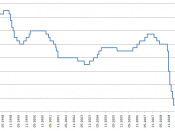Monetary Policy is a macroeconomic policy that is concerned mainly with the actions of the Reserve Bank of Australia on behalf of the government to manipulate the cash rate, thus influencing the cost and availability of money in the economy, to affect the level of aggregate demand. The primary goal of the Monetary Policy is to achieve price stability by ensuring that inflation as measured by the CPI stays within the target range of 2-3% on average per annum. By targeting inflation it allows for the other key objectives of economic growth and full employment to be achieved.
The supply of money is measured in a variety of ways. Two commonly used measures of the money supply are M3 and Broad Money.
1. M3: This is calculated to be the total volume of coins and notes in the hands of the general public, plus any deposits in the bank, plus any deposits that building societies and credit unions have with the banks.
2.Broad Money: As the name implies, this measure of money is slightly more inclusive than the measure of M3. Broad money is M3 plus any deposits that are held with Non-Bank Financial Institutions (NBFIs). An NBFI is a financial institution that is licensed to hold deposits, but is not a bank. For example, building societies, life insurance companies and superannuation firms are all NBFIs.
*The Rba targets inflation because:Low inflation is seen as a precondition for the achievement of other key objectives. In order for sustained economic growth to occur, low inflation is necessary as it ensures that both consumer and business confidence will exist, assisting in making our exports internationally competitive and works towards generating employment. If inflation is beyond the target of the RBA, they will implement contractionary monetary policy to stifle aggregate demand.


